The Georgian Bay Symphony enters a new era.
by Rebecca Diem // Photography by Anya Shor
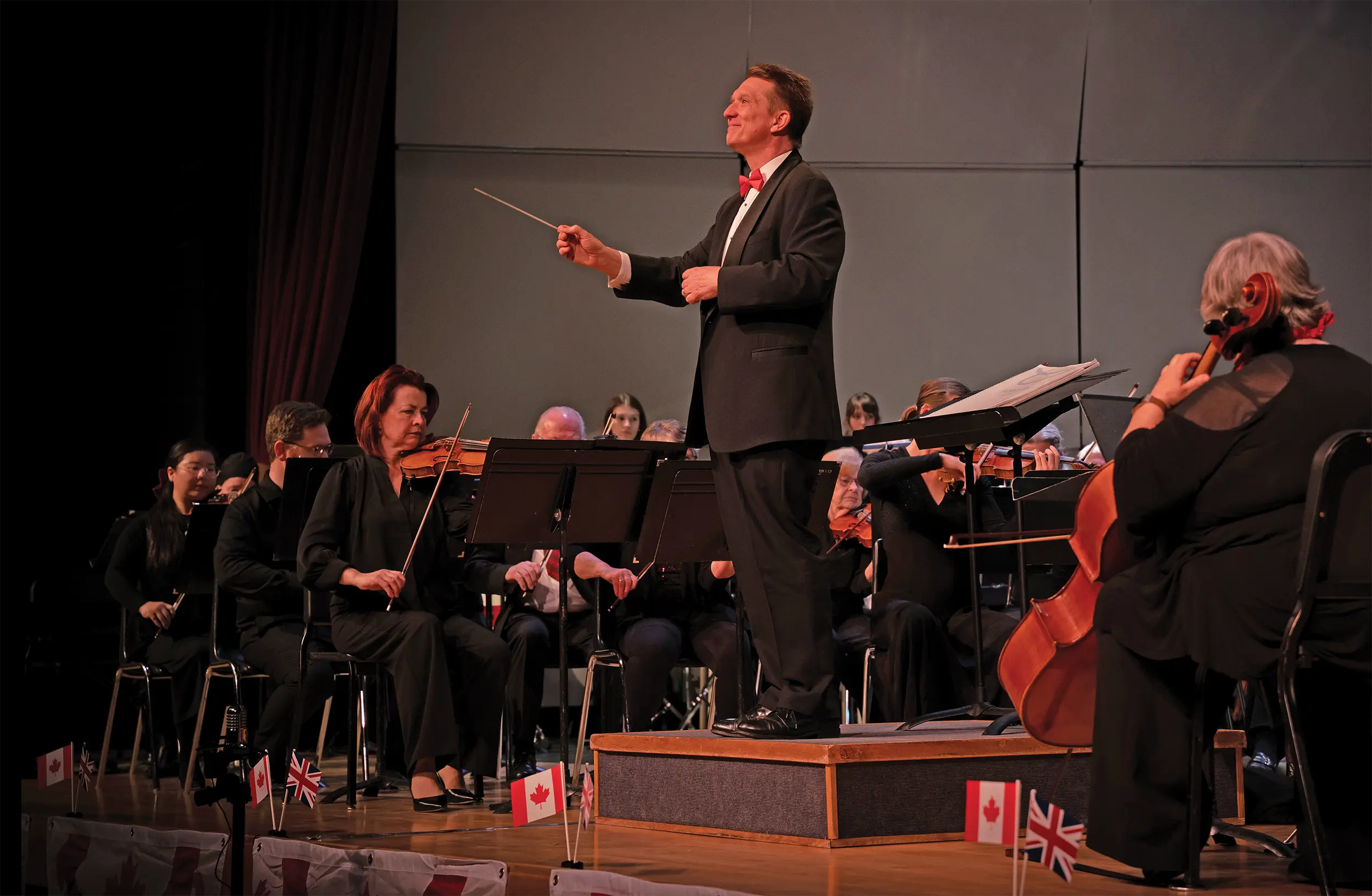
Enter the auditorium, rows of deep burgundy seats stretching up to the rafters. Feel the buzz of excitement from the crowd as members of the audience pause to greet friends or wave to one of the musicians assembled onstage. The instruments gleam against the musicians’ formalwear—black, sleek, professional.
The room darkens, and you welcome the concertmaster to the first chair with applause, followed by the conductor. He has a bounce in his step, looking eager and in his element, a bright red cummerbund adding flair to his sombre tails. Beckoned by the flick of his baton, you stand and join your voice in chorus to a rousing, emotional O, Canada.
The stress melts from your shoulders as you feel the vibrations of the orchestra tremble upwards through your toes. You are embraced by the all-encompassing sound alongside the community of music lovers and patrons experiencing it with you.
This is the Georgian Bay Symphony. It’s the final performance for the season, but the beginning of a new era for this community orchestra under the leadership of music director Jeffrey Pollock.
For more than 50 years, this primarily volunteer-based orchestra has enchanted audiences young and old with live performances.

In this age of media saturation, instant gratification, and generative AI mimicry, how does an orchestra not merely survive, but actually thrive?
In 1972, a small group of talented local musicians formed the Georgian Bay Symphony (GBS). For more than 50 years, this primarily volunteer-based orchestra has enchanted audiences young and old with live performances. From holiday music matinees to contemporary pieces and classics we grew up listening to in the background of our Saturday morning cartoons, the GBS has played it all.
It’s no wonder that musicians travel hours to be part of this orchestra, or that Pollock himself commutes from Hamilton for his new role. Even during the COVID-19 pandemic, the GBS was one of the few community orchestras that successfully pivoted to virtual performances, rehearsing together weekly online.
“It’s the communal, shared experience,” explains Pollock, when asked about the continuing appeal of live music. “You’re dedicating a chunk of time to be in public, to be with people experiencing something at the same time.”
Beyond conducting the orchestra during performance and rehearsals, as music director Pollock is also responsible for selecting the music for the season and supporting the musicians in learning to play each piece. The upcoming 2025-2026 season will be his first time curating the entire programme.
Pollock was chosen by the orchestra members following a year-long search in which the candidates auditioned for the musicians they were asking to lead. With his energy, passion, and cheeky commentary inviting the audience into the experience, Pollock has been lauded for his engaging leadership style.
“He’s just amazing.”
“Infectious enthusiasm.”
“Joi de vivre.”
The reviews were overwhelmingly positive when asked to describe what Pollock brings to the GBS.
“It’s my mission to connect with the audience,” he says. “To give enough of an introduction to the music that we’re playing, that if people don’t know a single thing about it, they have a foothold, they have a way in so that they feel they’re taking part in what we’re doing, and I think that’s something that I do really well, inviting people in.”
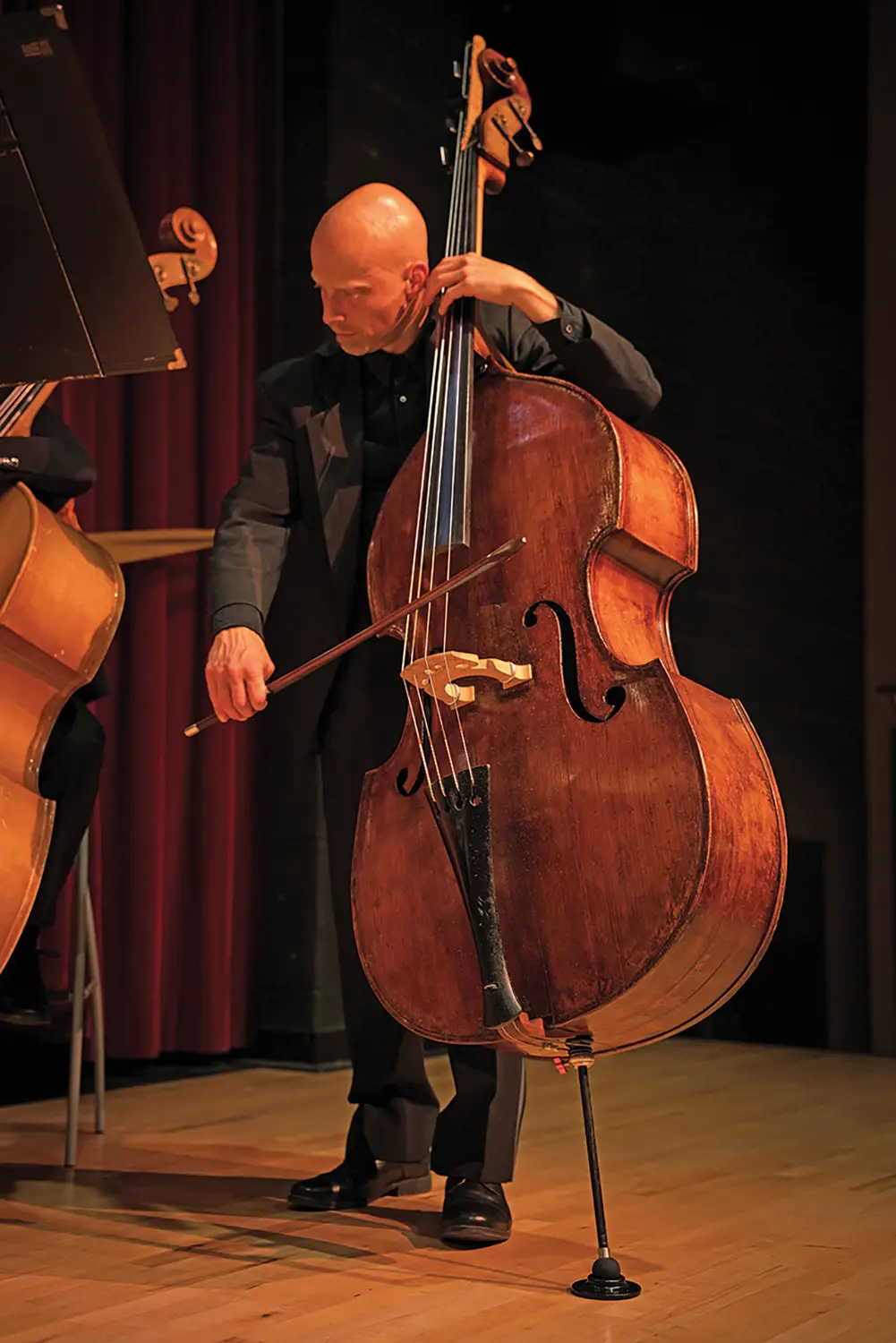
Pollock notes the added benefit of a community orchestra being less intimidating for audiences who have never attended the symphony. Even the location, the 750-seat OSCVI Community Auditorium, is a friendly and welcoming space by its very nature as part of an elementary school. Artwork by former students is featured proudly on the walls.
Pollock chuckles when asked about a dress code: “Come as you are! I never care what people wear—I care that they listen.”
The importance of connecting with the audience is echoed by orchestra members, who also look to the conductor and to each other for feedback while playing.
“The audience is the other character,” explains Jen Burak, a violinist, on the exchange of energy. “Communication with the art form, and between the two, is really key.”
“We train to do this,” says Meryl Gillmore, a music teacher who plays the flute alongside former students who have since joined the orchestra. “Being a musician, there’s lots of hours playing individually, practicing our parts, learning our craft. And then we come together to be part of something bigger than just the one instrument.”
Burak agrees, “With the world being the way it is, it’s an oasis for me, personally, to sit and play in this orchestra and challenge myself—because it is challenging.”
Earlier this year, I was invited to attend a GBS rehearsal and meet their new music director. I listened as the violins practiced a particularly difficult section again and again, the faint sounds of smaller groupings of brass players and percussionists echoing faintly through the halls. They may have practiced their craft all their lives, but each performance is prepared through meticulous individual and group rehearsals.
The most striking thing was seeing everyone in their street clothes. Here, in sneakers and T-shirts, the musicians smoothly transitioned from rehearsing achingly beautiful soundscapes to devouring a box of donuts during the break, filling the room with friendly banter and peals of laughter.
“Music you love played by people you know” is the orchestra’s tagline. Having lived away from the area for more than a decade, I had no expectations. And yet, as I looked around the room, I saw a woman I’d met at a mutual friend’s potluck, a former math teacher, and a long-time family friend I had not seen in years.
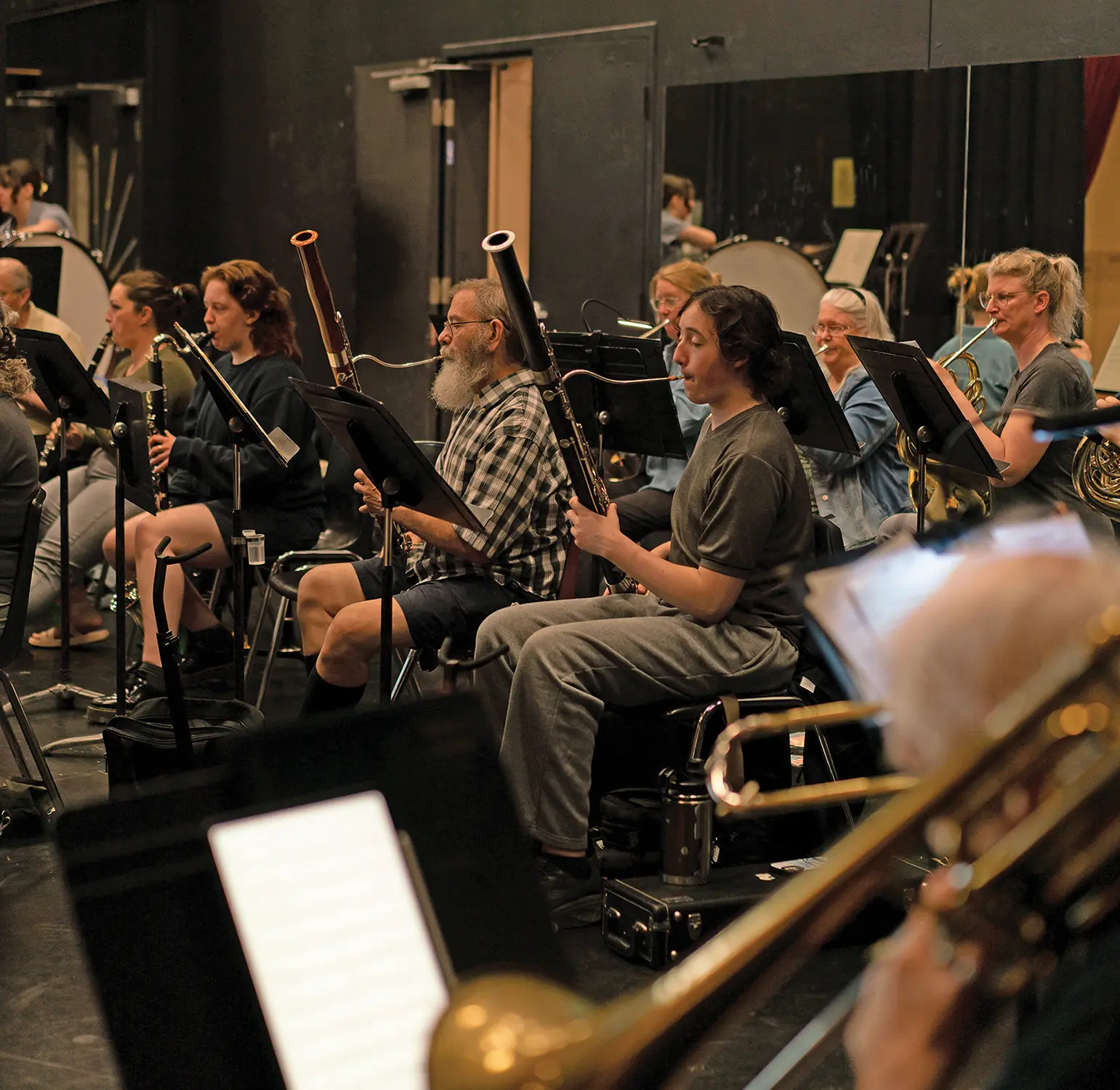
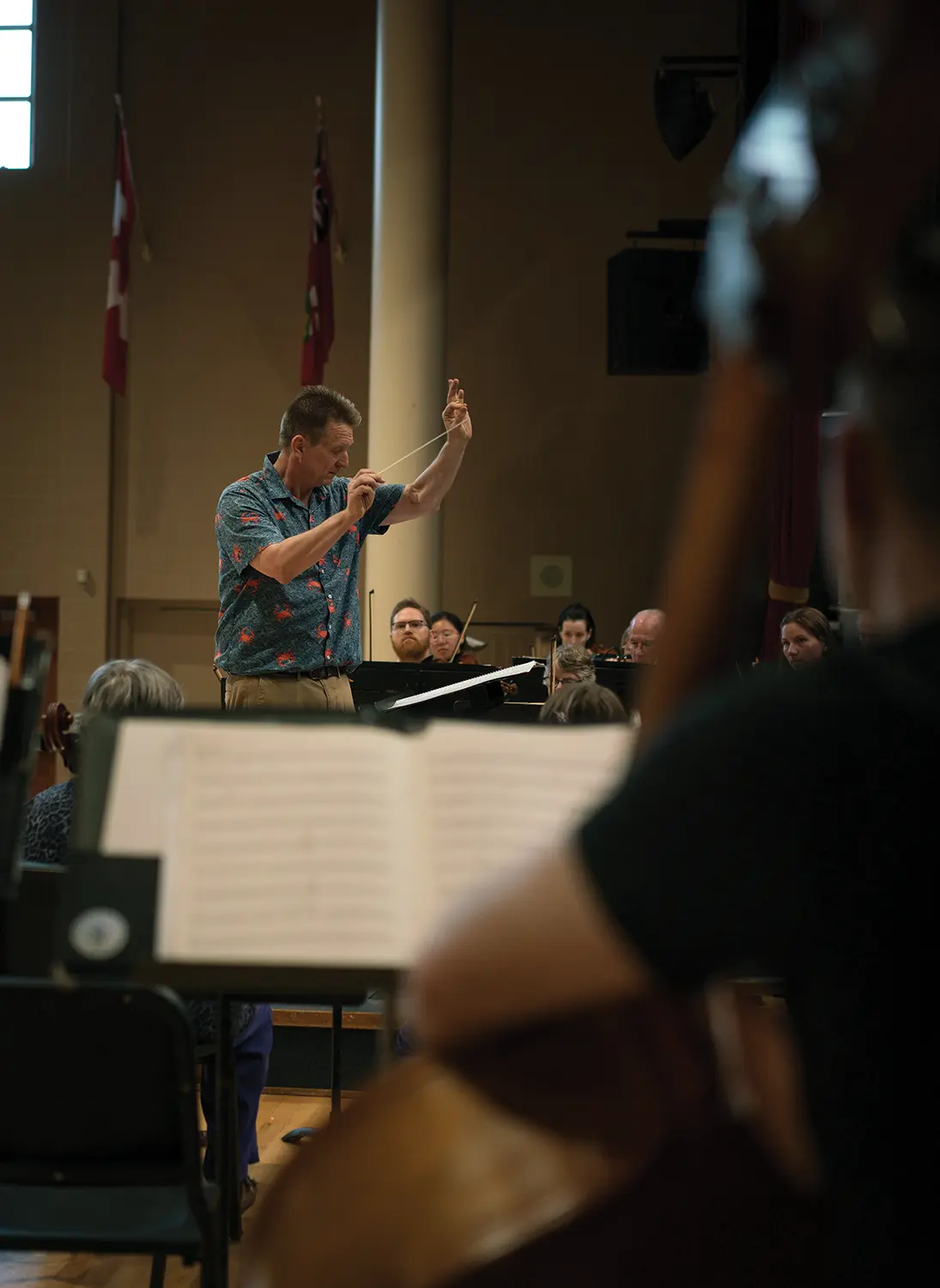
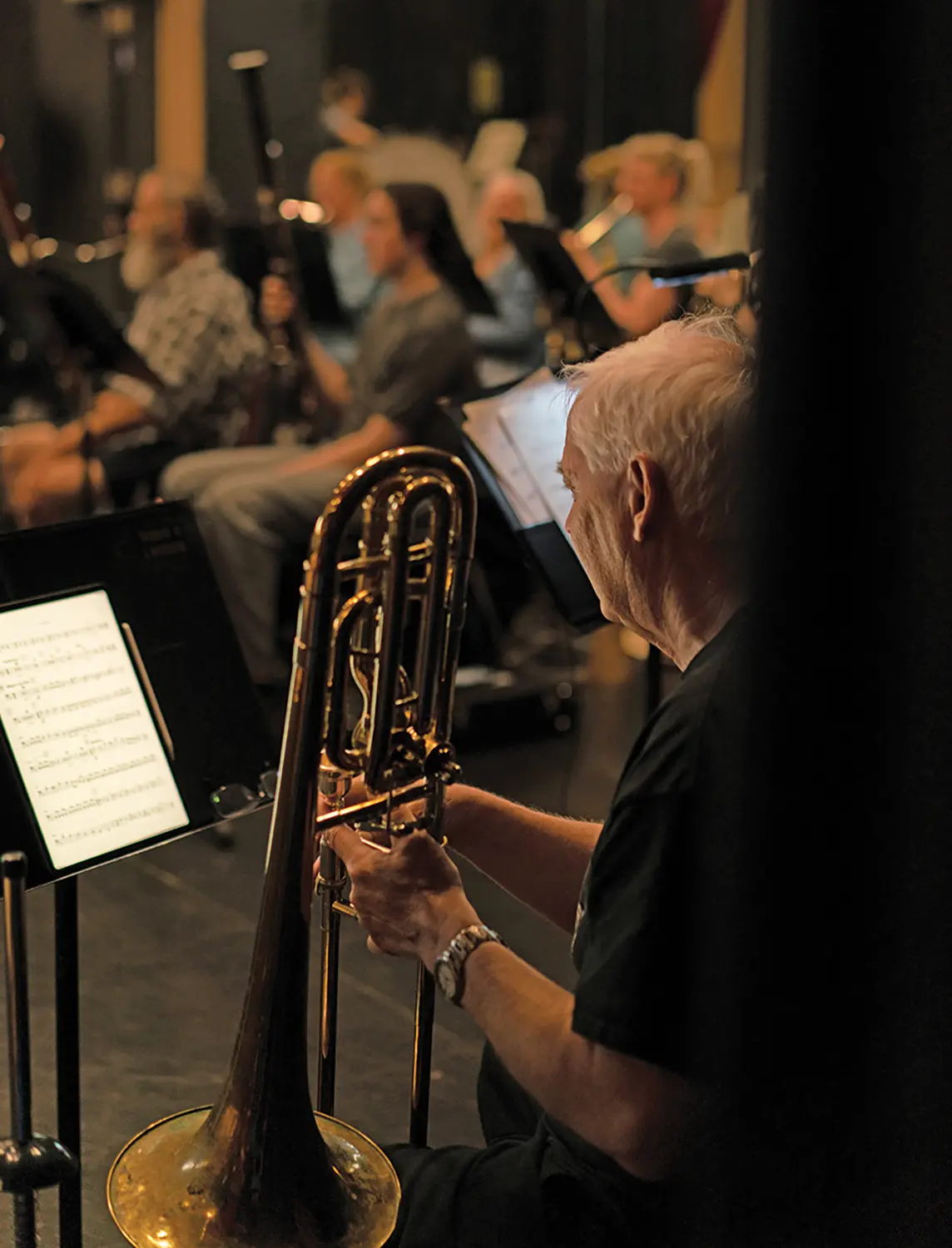
I joined Pollock in the stands to ask how his work on the upcoming season’s programming was coming along.
“It’s probably the hardest work I have to do,” Pollock explains. “I choose music that will appeal to the community, hopefully. Maybe things that they know, maybe things that they don’t know, but ultimately that they will enjoy. I feel like I’m a chef and I’m having people to dinner—I’m making sure that the vegetable dish that they may never have had before will complement what they might know.”
At the past season’s final performance on May 24, “Last Night at the Proms, eh?” Pollock announced his new program to audible gasps of delight—just before launching into an enthusiastic rendition of the Hockey Night in Canada theme.
Balancing ambition and charm, the 2025-2026 season promises delightful pairings and notable guest appearances:
On October 25, the orchestra will be joined by CBC Radio 2 host Tom Allen for an evening of musical storytelling.
In December, a new partnership with the Shoreline Chorus—a 45-member community choir—will spread the season’s tidings.
A Valentine’s Day matinee entertains listeners with the greatest love songs performed by acclaimed singers from across Ontario.
The April 11 performance, aptly titled “Double, Double,” includes four soloists playing two duets: Bottesini’s Gran Duo and Mozart’s Concerto for Flute and Harp.
Finally, on May 23, there is “Bravery and Brilliance,” featuring Juno Award-winning pianist Philip Chiu and Stravinsky’s Firebird in its entirety.
One of the best ways to support the orchestra is buying a season subscription, which includes tickets to all five regular performances.
For Pollock, the musicians are his most important stakeholders. “I love working with this group,” Pollock says. “People are here because they really want to be here. It is not something they take for granted. It’s not something I take for granted. We can do all kinds of things with our time, [but] when we choose to come together like this to experience something communally, it’s really special.”
Sustaining the arts is itself a communal effort, including patrons, board members and volunteers. Community contributions add to the lore of the GBS, most notably in the form of “Miss Agnes,” the Yamaha concert piano bought with the generous support of Agnes Nairn Brown in 1989. And the orchestra gives back to the community too, particularly in the form of scholarships for young musicians.
From the ache of our deepest sorrows to the transcendence of our greatest joys, experiencing the orchestra live, as a community, felt deeply meaningful. This music is embedded in our celebrations, our traditions, our moments of grief—times when we need to feel less alone—and it is a full-body experience to feel the goosebumps rise on your skin as the crescendo of sound fades into silence, that moment of collective appreciation just before the applause.
“It’s important. We crave connection,”
Pollock explains, before we say goodbye. “We connect in this way, in this space, and we share what we love.”









